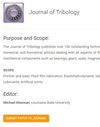Dry sliding wear performances of AA5052 hybrid composite brake disc materials reinforced with in-situ synthesized TiC and multi-walled CNT
IF 3
3区 工程技术
Q2 ENGINEERING, MECHANICAL
引用次数: 1
Abstract
In this research, aluminum alloy AA5052 based hybrid metal matrix composites (MMCs) were fabricated using in-situ synthesized titanium carbide (TiC) and ex-situ multi-walled carbon nanotube (MWCNT) as reinforcements using the liquid metallurgy route. The wear characteristics of the aluminum hybrid MMCs were analyzed under the synergistic effects of TiC and multi-walled CNT. Pin-on-disc wear apparatus was utilized for the experimental investigation where the hybrid composite is considered as the disc, and the traditional brake pad material is treated as the pin. The parameters i.e. applied load, sliding velocity, sliding distance, and reinforcement content are treated as inputs, whereas the wear rate and coefficient of friction are considered as output variables for the tribological experimentation. The influence of various input process parameters on the tribological behavior of the fabricated samples was investigated. The plastic deformation attained by the base alloy exhibited the delamination, which indicates the adhesive wear, whereas the composites exhibited abrasive nature as analyzed from the wear surface morphology. The wear debris was characterized by flake-sized, corrugated, and oxidized by the microstructural study.原位合成TiC和多壁碳纳米管增强AA5052复合制动盘材料的干滑动磨损性能
本研究采用液体冶金方法,以原位合成的碳化钛(TiC)和非原位多壁碳纳米管(MWCNT)为增强材料,制备了铝合金AA5052基复合金属基复合材料(MMCs)。分析了在TiC和多壁CNT的协同作用下,铝基复合材料的磨损特性。采用销-盘磨损装置进行了试验研究,将混合复合材料视为制动盘,将传统的制动片材料视为销。参数,即施加的载荷、滑动速度、滑动距离和补强含量被视为输入,而磨损率和摩擦系数被视为摩擦学实验的输出变量。研究了各种输入工艺参数对所制备样品摩擦学性能的影响。基体合金获得的塑性变形表现出分层,这表明粘着磨损,而从磨损表面形态分析,复合材料表现出研磨性。通过微观结构研究,磨损碎屑具有片状、波纹状和氧化的特征。
本文章由计算机程序翻译,如有差异,请以英文原文为准。
求助全文
约1分钟内获得全文
求助全文
来源期刊
CiteScore
4.20
自引率
12.00%
发文量
117
审稿时长
4.1 months
期刊介绍:
The Journal of Tribology publishes over 100 outstanding technical articles of permanent interest to the tribology community annually and attracts articles by tribologists from around the world. The journal features a mix of experimental, numerical, and theoretical articles dealing with all aspects of the field. In addition to being of interest to engineers and other scientists doing research in the field, the Journal is also of great importance to engineers who design or use mechanical components such as bearings, gears, seals, magnetic recording heads and disks, or prosthetic joints, or who are involved with manufacturing processes.
Scope: Friction and wear; Fluid film lubrication; Elastohydrodynamic lubrication; Surface properties and characterization; Contact mechanics; Magnetic recordings; Tribological systems; Seals; Bearing design and technology; Gears; Metalworking; Lubricants; Artificial joints

 求助内容:
求助内容: 应助结果提醒方式:
应助结果提醒方式:


